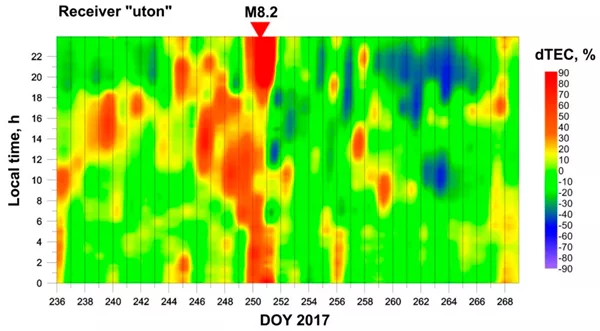Under the European Cooperation in Science and Technology (COST) project, researchers have studied ionospheric disturbances in the context of large-scale earthquakes using a variety of methods. The research was aimed at examining changes in ionospheric parameters based on data from various atmospheric and European global navigation satellite systems in order to determine whether earthquakes can be predicted from atmospheric and ionospheric disturbances associated with earthquakes. From Hungary, Veronika Barta, a researcher at ELKH CSFK GGI, took part in the project. A study presenting the research findings was published in the Geosciences.
A group of researchers from Cyprus, Russia, Nepal, Hungary, Indonesia, Greece and Turkey studied ionospheric disturbances, using various methods, which occurred prior to and during three recent large-scale earthquakes in Mexico with magnitudes of 6.6, 8.2 and 7.1. A special feature of the dates of the earthquakes (21 January 2016, 8 and 19 September 2017) is that the second earthquake erupted precisely during the period of a solar flare-induced geomagnetic storm. This meant that the researchers also studied ionospheric changes in another 37 periods before an intensive (M> 4) earthquake, which also occurred in 2017.
Veronika Barta and her colleagues, representing the ELKH CSFK Geodetic and Geophysical Institute, studied the temporal variation and spatial distribution of the Total Electron Content (TEC) derived from the European Global Navigation Satellite System (GNSS) data in the vicinity of these earthquakes, and also carried out spectral analysis. In addition, special attention was paid to the temporal variation and regional distribution of a parameter derived from an atmospheric model, the so-called Atmospheric Chemical Potential (ACP).
In recent decades, a number of theoretical studies have focused on the possible physical mechanisms of pre-earthquake atmospheric disturbances, as well as magnetospheric and ionospheric disturbances. According to the Lithosphere – Atmosphere – Ionosphere – Magnetosphere (LAIMC) coupling model, before the earthquake, micro-cracks form in the Earth's crust, through which radon gas is released. Increased radon concentrations ionise the air, creating water condensation nuclei, and the latent heat released during condensation can modify atmospheric temperature, humidity, and greenhouse effect.
Increased surface ionisation alters the electrical conductivity of the atmosphere, which can cause electron and ion plasma density anomalies in the ionosphere through the global atmospheric electrical circuit between the surface and the ionosphere, and this can be well clearly detected in changes in total electron content. Ionospheric disturbances are able to penetrate the magnetosphere along the Earth’s magnetic lines of force. Atmospheric chemical potential is a new, integrated parameter related to radon change, which is related to the latent heat released during the condensation of water molecules, when water molecules detach from water droplets. Ionization caused by an increase in radon concentrations prior to earthquakes releases latent heat, as the number of condensation nuclei increases. The atmospheric chemical potential is suitable for detecting just this excess heat.
According to the results of the study, atmospheric and ionospheric disturbances related to earthquakes can be detected simultaneously using several parameters and methods, even during periods that are geomagnetically active. The researchers detected large and short-term changes in total electron content in the few hours and days before the earthquakes that were studied. According to the spectral analysis of the electron content, short disturbances in the ionosphere with a period of 20–25 minutes developed over the epicenter of the earthquakes. In most cases, regional ionospheric disturbance was associated with an increase in the ACP parameter. In order to obtain a comprehensive and clear picture of the atmospheric and ionospheric changes before earthquakes, the researchers said it would be worthwhile to create a network of stations in seismically active regions that could simultaneously study temperature, relative humidity, radon, atmospheric electrical parameters, and changes in total electron content.

Ionospheric TEC changes during the outbreak of the M = 8 magnitude earthquake in Mexico on 8 September 2017. Along the abscissa are the Days Of Year 2017 (DOY) from August 24 (236) to September 25 (268). The ordinate indicates the local time. The 8.2 magnitude earthquake on September 8 occurred on the 251st day. The color scale shows the percentage deviations of total electron content (TEC) from the 15-day running average based on data from a UTON GNSS measuring station near the epicenter. A geomagnetic storm also took place before the earthquake (on the 7th and 8th).
More information:
Oikonomou, C.; Haralambous, H.; Pulinets, S.; Khadka, A.; Paudel, S.R.; Barta, V.; Muslim, B.; Kourtidis, K.; Karagioras, A.; Inyurt, S. Investigation of Pre-Earthquake Ionospheric and Atmospheric Disturbances for Three Large Earthquakes in Mexico. Geosciences 2021, 11 (1), 16.